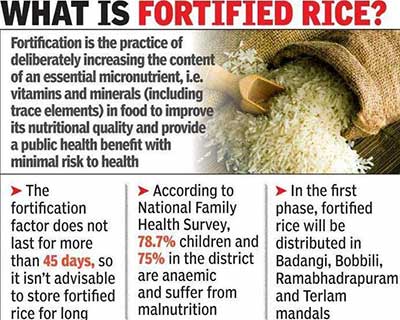GS-2: Issues relating to Poverty and Hunger;
GS-3: Public Distribution System, Issue of buffer stocks;
Key phrases- PDS, Rice bran oil, Fortification, Ethanol blended fuel
Why in news-
Union government discusses offering fortified rice in PDS
Analysis:
What is fortification?
- It refers to the addition of key vitamins and minerals to increase the nutritional value of rice. The fortified Rice generally contains Vitamin A, Vitamin B1, Vitamin B12, Folic Acid, Iron and Zinc.
- Rice can be fortified by adding a micronutrient powder to the rice that adheres to the grains or spraying the surface of ordinary rice grains in several layers with a vitamin and mineral mix to form a protective coating
- As per WHO Fortification of rice with iron is recommended as a public health strategy to improve the iron status of populations, in settings where rice is a staple food.
Importance of fortification
- Fortification is a safe method of improving nutrition among people. The addition of micronutrients to food does not pose a health risk to people
- Socio-culturally acceptable way: It does not require any changes in the food habits and patterns of people. It is a socio-culturally acceptable way to deliver nutrients to people
- Cost-effective: Food fortification is a cost-effective strategy to improve the nutrition status of populations and it is associated with high economic benefits.
- food and agriculture report 2018 - India houses 25 percent of undernourished people in world (total 800ml in world)
- 53 percent of countries women in age group 15-49 are anaemic-NFHS
- Also, it is estimated that 50-70% of these birth defects are preventable. One of the major causes is deficiency of Folic Acid.
- Quick implementation: It can be implemented quickly as well as show results in improvement of health in a relatively short period of time.
Status of fortification in India
- Centrally sponsored pilot scheme on “Fortification of Rice and its Distribution under Public Distribution System (PDS)” for a period of three years beginning 2019-20
- Mission Poshan 2.0 to strengthen nutritional content, delivery, outreach, and outcome.
- Edible oil: Fortification of edible oil, too, was made compulsory across the country by FSSAI in 2018.
- Wheat: The decision on fortification of wheat was announced in 2018 and is being implemented in 12 states under India’s flagship Poshan Abhiyaan to improve nutrition among children, adolescents, pregnant mothers
- Milk: Fortification of milk was started in 2017 under which the National Dairy Development Board of India (NDDB) is pushing companies to add Vitamin D.
Issues with over emphasis on fortification
- Loading the system with iron has its own problems. Iron has oxidative properties and it can react with intestinal mucosa, which could become damaged by existing infections, which are widespread in India
- Sometimes, fortification can have the opposite effect. Natural foods contain protective substances such as phytochemicals and polyunsaturated fat that are adversely affected by the process of blending micronutrients
- Researchers are worried that the push towards fortification is more to help the industry than the people and is an international market driven solution and without any scientific logic.
- High cost: The fortification expenditure of only the rice delivered through the social safety networks will cost the public exchequer about Rs. 2,600 crores annually.
Way ahead
- Diverse and quality diet is more helpful: Instead of fortification, the quality of diet should be improved. Increasing the intake of foods from animal sources and fruits would be more helpful. National Institute of Nutrition, too, recommended that a diverse natural diet is required
- Food can be grown through Amrut Krishi, an organic farming technique that would lead to an increase in food nutrition
- Another solution was breast feeding with proper latching techniques. It could make critical impacts on nutrition deficiency in the critical first 1,000 days.
- Connect local communities, farmers, micro, small and medium processors and others with local nutrition programmes. They can supply the raw materials as well as any locally prepared food-to-food fortificants such as syrups, biscuits, porridge, powders and various products made from local ingredients like starchy foods, vegetables, fruit,
India’s PDS system
- FCI procures from farmers-provides farmers with MSP, protects them-stock used for protecting price fluctuations in market by maintain buffer stock-these grains allocated to various states
- Distributed at subsidized prices through chain of fair shops under PDS- also through means like food for work, mid-day meal scheme-80 crore NFSA beneficiaries and 8 crore migrants.
Ethanol blended fuel
- Government plans 20% diesel requirement using biodiesel- Jatropha, Mahua, Neem
- PM Jivan Yojana-Viability Gap Funding (VGF) to Second Generation (2G) Integrated Bioethanol Projects-ethanol produced to be mandatorily supplied to OMCs
- National bio energy mission-to raise with wasteland based integrated energy plantation and power generation systems
- The overwhelmingly dominant factor in the production of ethanol in India is the price and availability of molasses-central government sets price but states control movement of molasses
Source: The Hindu BL , PIB
Mains question:
Q. The issue of malnutrition and hunger in India has been a pestering problem
since independence. What are the reasons? Could fortification be an effective
solution to this problem? (15 Marks, 250 Words).









